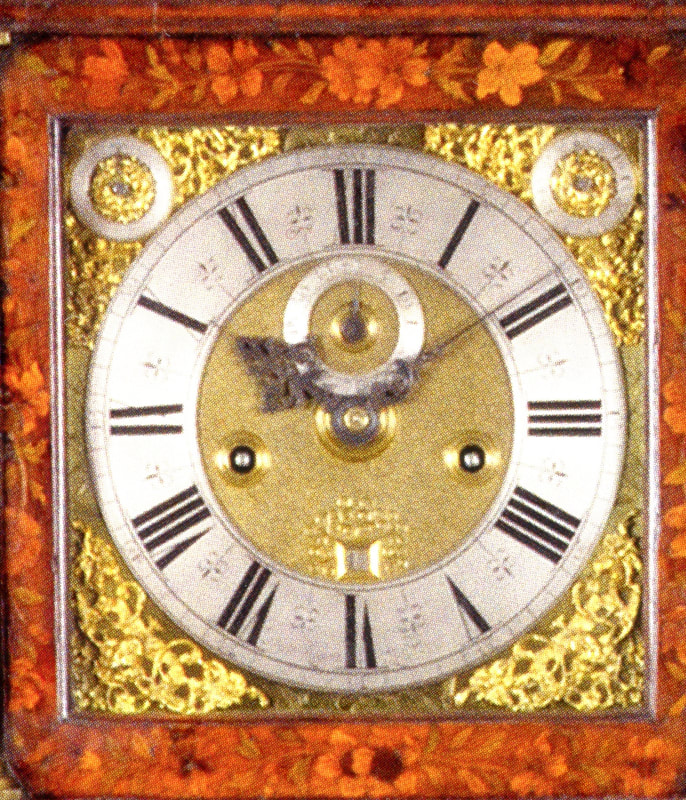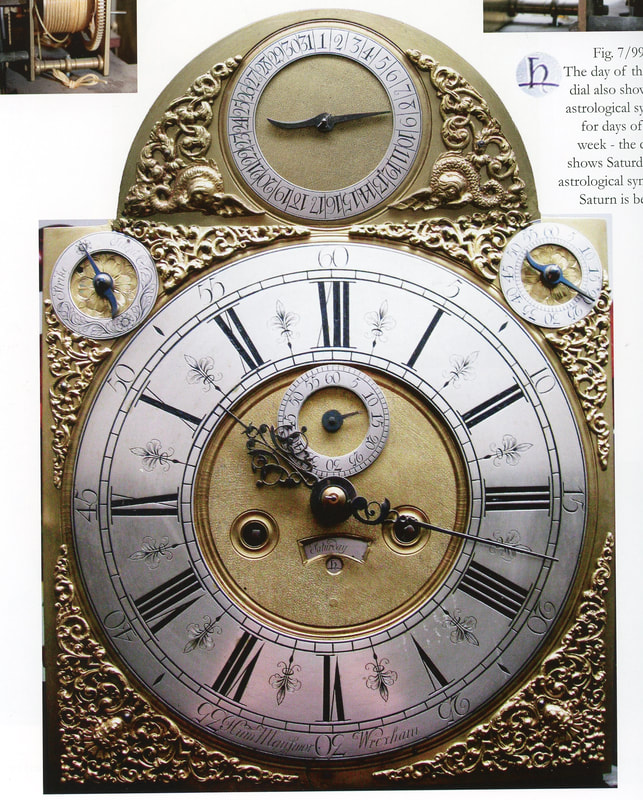|
I have often wondered why no-one has written a book about Daniel Quare because he was one of the finest and most ingenious clock and watchmakers of the late 17th and early 18th centuries. Daniel Quare was a Quaker at a time when there was great prejudice and ill-feeling towards Quakers because they were different and had different beliefs. They were treated as social and religious outcasts and persecuted by the establishment. Daniel Quare is thought to have been born about 1648 in Somerset and apprenticed to an unknown master 1662-1669 and probably worked as a journeyman until 1670. He was working in the parish of St Martin-le-Grand, Westminster by 1671 when the CC discovered him and made him a brother of the company on 3 April 1671 as a great (turret) clockmaker. Daniel married Mary Stevens, daughter of Jeremiah, deceased maltster of Wickham, Bucks., on 18th Apr 1676 at Devonshire House, Quaker Meeting. They moved to Aldersgate in 1678, then Lombard Street and finally in 1685 to the King’s Arms, Exchange Alley. After Quare’s introduction to King William III and being made clockmaker to the King, his clocks and watches were in great demand. He also bound a number of skilful apprentices through the C.C. who became fine clockmakers too. Richard Vick and John Zachary were two of his former apprentices who later excelled in the craft. While, Faith Leake apprenticed to John White and turned over to Daniel Quare in 1677 and freed in Jan 1685/6 was interesting because both Daniel and his wife Mary attended the marriage of Faith’s sister Hannah who married another Quaker clockmaker, Ninian Burleigh. Ninian Burleigh, clockmaker of Talbot Court, Gracechurch St., London, son of John Burleigh of Tockwith, Yorks, yeoman, married Hannah Leake of Cheapside, London, daughter of John Leake deceased merchant of Selby, Yorks., at the Bull and Mouth, Quaker Meeting, London on 26th November 1691. The witnesses included Daniel and Mary Quare, his apprentice John Zachary and George Leake who had been apprenticed to John Wright in C.C. Jan. 1685/6 and was freed 29th Sept 1693, were also present. Ninian Burleigh joined the C.C. as a brother on 4th July 1692. Ninian and his wife moved to the North East, staying for a short time in Pontefract, Yorks, before moving to Durham by 1696. The question which comes to mind is, was there some trade connection between Burleigh and Daniel Quare or did the Quare’s just happened to be invited to the wedding? Another of Daniel Quare’s apprentices John Nolson had been bound by John Pitcher, a freeman of the B.C., in the C.C. in Sept 1689 and turned over to Quare and freed on 6th Dec 1697. John Pitcher had been freed in the B.C. in 1688 and joined the C.C. as a brother on 2nd Sept 1689 and married Susan Newland in Aug 1693 at St Andrews Holborn, at the age of 34. John Nolson, formerly of Drury Lane, London, must have decided to go to the USA but unfortunately, he died at sea on the ship ‘Tartar’ in 1705.
According to Alan Lloyd a full record of Daniel Quare’s career was given in the “Friends Quarterly Examiner” of 1900. His rise up the social ladder is reflected in those important people who attended the marriages of his children. In 1705 Anne Quare married John Falconer when those attending were the envoys of Venice, Florence, Hanover, Portugal, Sweden, Prussia and Denmark. In 1712 when his son Jeremiah and daughter Mary were both married, the guests included the Earl of Orrery, the Duke of Argyll, the Venetian Ambassador, the Compte de Briancon, etc. Then in 1715 when his daughter Elizabeth married Silvanus Bevan, besides the Countess of Brocklinborough, the Count and Countess of Guicord, Francis de Fleurs and many others, as well as Sarah, Duchess of Marlborough were all present. An Act of Parliament prevented the English Royalty attending non-conformist services but the Princess of Wales attended the reception. Daniel Quare refused a pension of £300 a year as watchmaker to King George I, because his conscience would not allow him to take the oath; nevertheless, he was permitted access to the palace. Quare died on 21st March 1724 as a very wealthy clockmaker and his will proved on 24th March 1724 is most revealing. It contains legacies to his wife, son Jeremiah and his six grandchildren, which amounted to £7,200 (in today’s value £1,440,000). His daughters Mary and Elizabeth must have died childless because only his son’s children and those of his late daughter, Anne are mentioned. He left his properties in London and the country, to his widow Mary and the remainder of his estate to his son Jeremiah.
Richard Vick, as we have noted was an apprentice of Daniel Quare and when freed he was able to train his apprentices to make clocks as Daniel had taught him. Humphrey Maysmore son of Humphrey, a deceased clockmaker, was apprenticed to his mother in the BC and turned over to Richard Vick in Dec 1706; he was not freed in the BC but went to work at Wrexham about 1715. It is interesting to note that clocks made by Humphrey Maysmore resemble fig. 2 by Daniel Quare. His longcase clock dial in fig 3 made about 1730-40 shows similar features, namely, strike/silent and regulating subsidiary dials, to those on Daniel Quare’s clock of about 1695.
In his book “Old Clocks” H. Alan Lloyd makes interesting comparisons of the work of some of the leading clockmakers, including Thomas Tompion, Daniel Quare, Joseph Knibb, Joseph Windmills and Edward East, as well as a number of other fine clockmakers. We will look at the lives and work of some of these craftsmen in future blogs.
Meanwhile, you can find out more about Daniel Quare If you are interested in the Early Clockmakers of the 16th 18th Century, we have two books which might interest you: Early Clockmakers of the Blacksmiths' Company Clockmakers of Northumberland and Durham Check out our Special Promotions HERE
0 Comments
|
AuthorKeith Bates is an amateur horologist who has been researching clocks, watches and chronometers and their makers for over 30 years. Archives
August 2023
Categories
All
|




 RSS Feed
RSS Feed